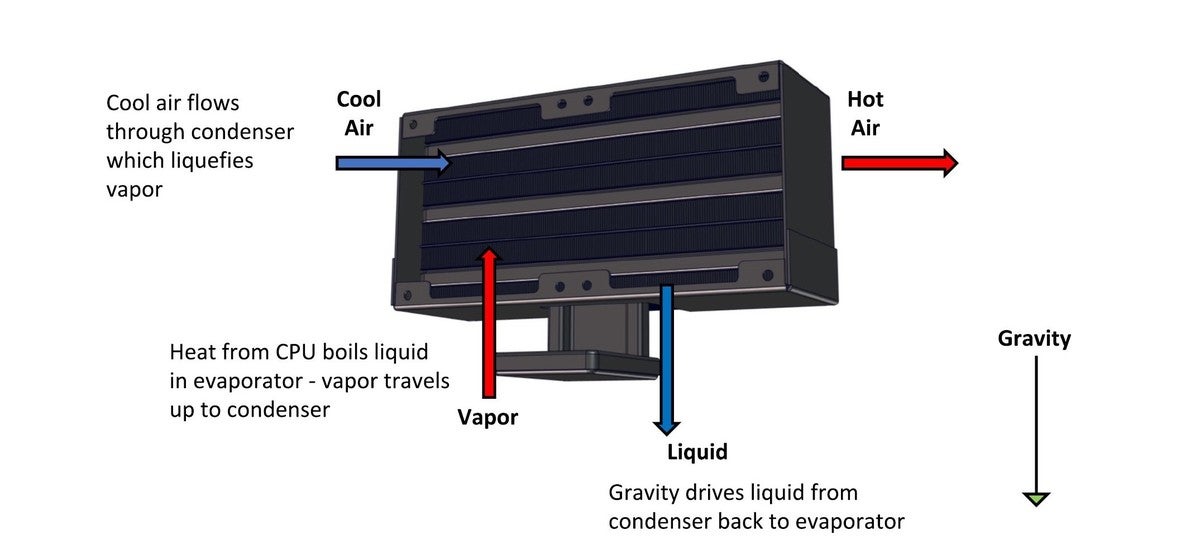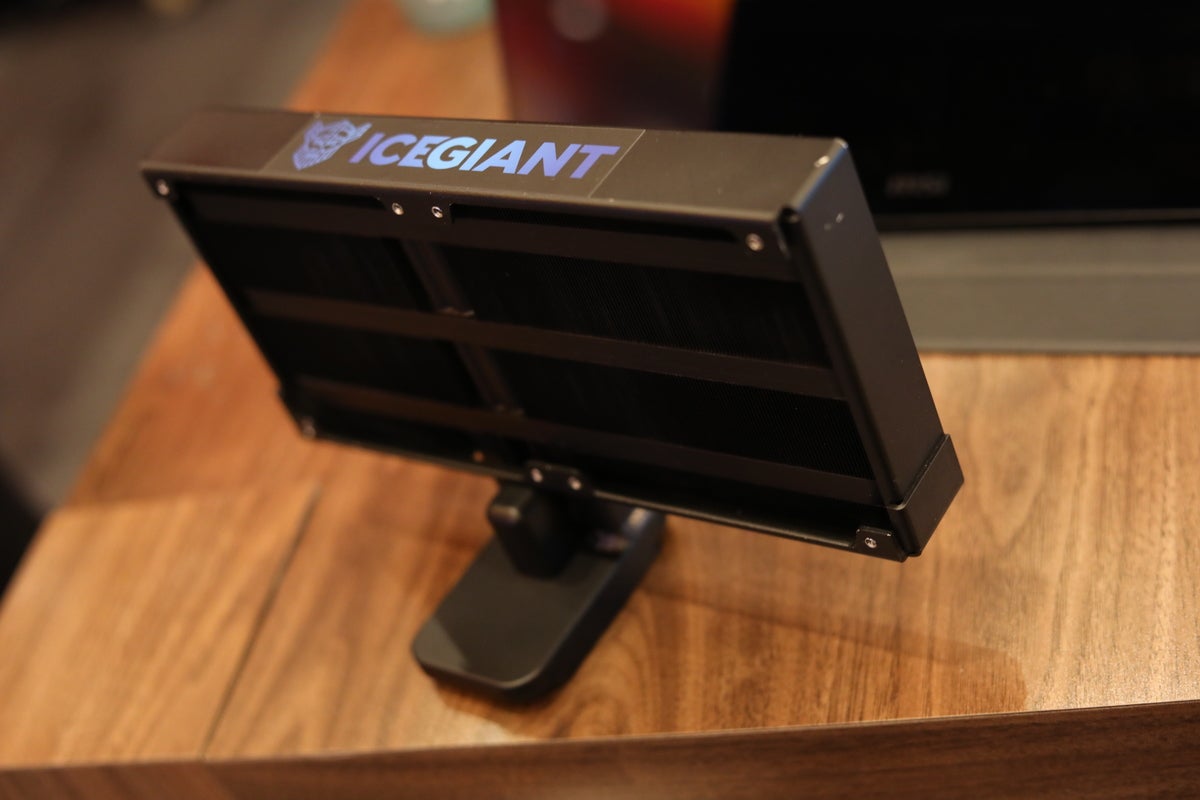IceGiant says its giant cooler can even tame AMD's giant Threadripper
- 27 January, 2020 22:00

CPUs may be getting smaller, but they’re not actually getting any cooler. Between AMD’s 32- and 64-core Threadripper CPUs, and Intel’s Core X chips, modern high-end desktop CPUs are producing more heat than ever dreamed of 10 years ago.
To address the heat, most high-end PCs use expensive and complex custom liquid cooling to hit peak performance, or self-contained all-in-one liquid coolers.
Enter IceGiant and its air cooler, based on the old concept of a thermosiphon. The company says it can outperform conventional air coolers and compete with liquid coolers. Before we dive deeper, though, we’ll review the current state of PC cooling.
 Brad Chacos
Brad Chacos
Digital Storm’s Aventum 3 uses custom liquid cooling to keep its GPUs and CPU cool. CLC’s are seen as the pinnacle of PC cooling today.
Custom Loop Cooling: The top of the food chain
At the top of the food chain (outside of exotic cooling for the overclocking sports) are custom loop cooling. Typically a copper water block is placed on the CPU or GPU and hooked up to inlet and and outlet tubes. Liquid (mostly water) is then pumped through the water block and through a radiator. The radiator is essentially a large aluminum or copper-finned box, which has fans attached to it to dissipate the heat. Most custom CLCs feature either very large distribution blocks or reservoirs to increase the volume of water in the system, which can help buffer high heat.
CLCs are typically the most effective, but also the most expensive and difficult to build with. For those who are averse to mixing water with electricity, they’re also the most risky due to the amount of water (even though it’s typically non-conductive) and the fact that you have to design and assemble it yourself.
 Thermaltake
Thermaltake
All-in-one coolers such as ThermalTake’s Riing 280 are popular today due to the cost-effectiveness.
All-in-One Cooling: Cost-effective leader
While custom loop cooling works well, it’s been too expensive and too complex for most mainstream users. Instead, many DIYers and PC makers have turned to much simpler All-in-One cooler systems, which contain the water block, pump, and radiator in a sealed package that’s easy to install in any PC. On the performance front, a well-designed AiO can compete with some CLC setups up to a certain thermal limit.
In the vast majority of gaming and performance desktops, AiO coolers have become the prevalent method due to their cost and efficiency. The biggest negatives to AiO systems is still the risk of failure (typically the water pump), as well as leakage from a break in a joint, and the inability to be serviced. AiO are sealed, but over time (years typically), liquid levels can drop as the water molecules pass through the tubing.
Air coolers: Cheaper, more “reliable”
 Gordon Mah Ung
Gordon Mah Ung
An Intel heat sink fan comes with many mid-range to low-end CPUs. Although not high-performance, they are engineered to handle the stock performance under most circumstances.
Most basic consumer desktop PCs CPUs are cooled using blocks of aluminum with extruded fins to increase surface area. These simple coolers are sometimes beefed up when needed by using a copper center slug, which conducts heat better than aluminum. Air coolers all work the same way: The aluminum or copper bodies act as head conductors from the hot CPU to the fins, where a fan forces air through them to dissipate heat.
 Adam Patrick Murray / IDG
Adam Patrick Murray / IDG
Cooler Master’s Hyper 212 uses direct contact heat pipes in a tower formation and is considered one of the best coolers in its class.
While the basic aluminum air cooler can work for a low-power CPU such as an Athlon or Core i3, higher-end CPUs need higher-end cooling. In air cooling, that’s typically meant moving from simple aluminum or copper conductors to heat pipes.
Heat pipes work by sealing a liquid—usually water—inside of a metal (usually copper) tube. The tube is typically pressed into a metal block or pressed flat to make direct contact with the CPU. As the water is heated up by its proximity to the hot CPU, it changes from liquid to steam and travels through the tube to the colder section, where fins and fans attached to the tube cool it off and it reverts or condenses back to its liquid state. Once cooled off, the liquid travels along a wick (which is typically fins), mesh, or a compacted or “sintered” powder that lines the inside of the heatpipe, back to the CPU. The liquid moves along the wick through a capillary process, which is similar to how water moves though a paper towel when you dab a corner of one into a cup of water.
Heat pipe-based coolers are so effective that they have replaced simple conduction air coolers in all but the cheapest PCs today. The very best air coolers can rival many All-in-One coolers in performance, too. Heat pipes do, however, have a limit, and that’s where IceGiant hopes to step in.
Got all that? Let’s finally dig into thermosiphons on the next page.
Page Break
Where a thermosiphon is different
Heat pipes are really good until you get to the point that a CPU is producing so much heat that the amount of vaporized liquid begins to overwhelm the liquid trying to swim downstream through the wick. This state in a heat pipe is known as a “dry out,” because you now have no liquid available to transfer heat. At that point, CPU temperatures will spike.
With a thermosiphon, liquid in the evaporator portion near the CPU works much like a heat pipe, in that the liquid is in a sealed metallic body and is heated into a vapor state. The heated vapor travels to the condensers though channels where it cools off and reverts to liquid form.
The key difference now is that rather than rely on a capillary method to return to the CPU where it can be boiled again, simple gravity takes the liquid back. In theory, this method has a higher thermal limit than heat pipes because there’s no wicking method that can be overwhelmed. The volume of liquid, though still small compared to a custom loop cooler system’s, is far greater than that of most heat pipes.
Unlike AiO coolers that rely on hoses, the metal body should prevent loss of liquid. IceGIant said if you did somehow suffer a catastrophic failure in the metal body, the liquid is dielectric, so it should not harm electronics.
Thermosiphons themselves aren’t new at all, even to computers, but no one has made a successful business of it.
 IceGiant
IceGiant
IceGiant’s cooler relies on a simple thermosyphon which isn’t easy to “dry out” like conventional heat pipes.
Thermosiphon vs. the world
In IceGiant’s testing, the company said it has pushed the cooler up to 500-watt capacity. The company claims it can outperform many existing giant coolers already on the market in high-temperature applications from AMD’s giant Threadripper CPU.
For example, the company said testing of the ProSiphon Elite on a simulated thermal test vehicle show the thermal resistance favoring its thermosiphon over heat pipe designs, including the massive Wraith Ripper. In the chart below that IceGiant blogged about, the Wraith Ripper in particular hits a dry-out at far lower thresholds than the ProSiphone Elite, IceGiant claims.
It’s not just IceGiant’s claims either. The company floated prototype coolers to both Tomshardware.com and Linus Tech Tips for preview. Both previews found the prototype cooler to be very effective. Linus Tech Tip’s tests, in particular, put the IceGiant cooler ahead of not just giant multi-pipe air coolers, but also some fairly beefy All-in-One liquid coolers. It was enough for the YouTube channel to proclaim: “Water cooling is dead. Meet the Thermosyphon!”
Of course, you’re probably wondering why even go with an air cooler over an All-in-One, even if the IceGiant can outperform it somewhat. The main argument for many is reliability. All-in-One coolers have pumps which can fail over time. The slow migration of water means eventual dry-out, too. Many people just don’t like to mix plumbing and electricity, which usually means an air cooler is the only choice.
 IceGiant
IceGiant
IceGiant claims their tests show the ProSiphon can outperform heatpipe-based coolers at high-temperature applications.
Thermosiphon weaknesses
Before you throw your money at the screen, you should know there are admitted weaknesses of the thermosiphon in a PC. The most obvious is its size. Though the ProSiphon Elite above slimmed down significantly from the prototypes used by Tom’s Hardware and Linus Tech Tips, it’s still incredibly huge and simply won’t fit in many PCs The prototypes also used Delta high-rpm fans that shriek like Banshees when running. IceGiant officials didn’t say what fans would be used on final products, but they’re likely to be much lower rpm than the Delta’s. For what it’s worth, IceGiant said retail parts will match the prototype’s performance.
The other issue is orientation. Unlike heatpipes, which can work against gravity somewhat, the ProSiphon must always have the evaporator lower than the condenser for the cooling cycle to work. IceGiant has designed it so the two orientations used in most standard tower or desktop cases will work just fine.
The company also points out that although heat pipes can function against gravity, unlike a thermosiphon which stops working, heat pipes’ effectiveness drops as the liquid has to climb uphill to reach the CPU.
The last weakness of the ProSiphon Elite is that it performs best at very high thermal loads. If you’re rolling a 32-core Threadripper or an 18-core Core i9, it does relatively well. If you’re running a Ryzen 7 or a Core i7, then it really won’t matter because those CPUs don’t produce enough heat for the ProSiphon Elite to be effective. You’ll see very little difference between the ProSiphon Elite and a typical AiO or heat-pipe cooler.
 Gordon Mah Ung
Gordon Mah Ung
IceGiant ProSiphon Elite is capable cooling even AMD’s mighty Threadripper. The Elite version is considerably slimmed down from prototypes making the rounds last year but company officials said it performs just the same as the prototypes.
You need a big CPU, too
The company’s engineers said its thermosiphon design is most effective on CPU designs that spread the heat out over a larger area, such as the five chips of a Ryzen Threadripper. A tiny, single die of a Core i9 at 5GHz means lower performance unfortunately, due to the current all-aluminum design. Company officials said future designs based on copper should change this issue for smaller CPUs.
As a smaller company, IceGiant said it will focus first on producing the ProSiphon Elite for high-end desktop applications. Later this year, it’ll introduce a Stealth version optimized to be quieter, and lower-cost. The company hopes the performance of the ProSiphon Stealth will be good enough that it can be sold as a semi-passive cooler, with only air flow from case fans cooling it.
IceGiant also hopes to extend the design to cool smaller CPUs, and bring out copper versions as well.
The company said it’s expected to ship production versions of the cooler this Spring for $120.
 IceGiant
IceGiant




